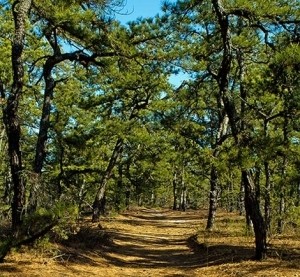
Gone are the days when many in the Northeast relied on pitch pine, and in many cases, gone are the trees themselves. But you can still find this historic tree with the alligator-scale-like bark if you know where to look. It persists in twisted bonsai form, clinging to ledges in coastal New England. Away from deadly shade cast by taller trees, it puts down roots in the scant pockets of soil the bedrock offers. Brendan Galvin’s poem “Pitch Pines” captures its standing well:
Some trees loft their heads
like symmetrical green bells,
but these, blown one-sided
by winds salted out of the northeast,
seem twisted from the germ.
Not one will lean the same way as another.
The tree’s stature is less diminutive when it grows on sand plains and downright stately when its roots can tap into ground water.
There was a time when pitch pine forests were prolific through parts of the Hudson Valley in New York and the Merrimack Valley in New Hampshire. In Maine, the tree accounted for 43 percent of the pine south of Penobscot Bay. Almost all the pines on Cape Cod were pitch, and present day Springfield and Chicopee, Massachusetts, sit on what was the largest known pitch pine plain in the Connecticut River Valley.
Today, pitch pine forests are largely gone throughout the region, save for a few oases: The Albany Pinebush in New York, Ossipee Pine Barrens in New Hampshire, outer Cape Cod, and Waterboro Barrens in Maine spring to mind. Connecticut is estimated to have lost 95 percent of its pitch pine and scrub oak barrens, making it the most decimated terrestrial ecosystem in the state.
An excerpt from Galvin’s poem perhaps best evokes how the tree was cut and burned relentlessly in the early days:
… till the desert floundered
out of the backlands and knocked
on the rear doors of towns and this peninsula drifted
in brushfire haze.
But, ironically, pitch pine decline can be pinned on forest protection as well as exploitation. It’s a species that plays well with fire;
and, clenching their cones
under crown fires, the grandfathers
of these pines held on until
heat popped their seeds
to the charred ground.
In the absence of fire, its population eventually suffers. It also suffers from competing trees, a trait that Henry David Thoreau picked up on in his journal, once writing: “To my surprise I find that in the pretty dense pitch pine wood … Where there are only several white pine old enough to bear … there are countless white pine springing up under the pitch pines (as well as many oak) and very few or scarcely any little pitch pines and they are sickly.”
U.S. Forest Service data corroborate the absence of new generations of pitch pine seedlings in Connecticut and a substantial mortality rate of older trees. Documented pitch pine/scrub oak ridgetop and sand barrens are down to around 0.04 percent of the Connecticut forest, and the conifer now comprises less than one percent of the pines.
Candlewood, Pine Tar, Turpentine
Pitch pine was a godsend to the early colonists. They called it candlewood and, lacking tallow for candles, burned the resinous pine knots and shivers for illumination. Connecticut Governor John Winthrop wrote, in the 1660s, that pine knots were often all that remained from generations of fallen trees in fields that had been burned clear by the Indians; these knots were “provided without any labour but the gathering together.”
The use of candlewood in the Springfield area was mentioned in an April 14, 1652, treaty between the Agawam Indians and settlers. It was said that “a prudent farmer would as soon enter winter without hay as without pine.” Candlewood was sold to villagers for between 6 and 10 shillings per cartload in western Massachusetts. It reportedly lit rural homes in New Hampshire, Vermont, and Maine into the nineteenth century. Candlewood Hill in Francestown, New Hampshire, and Haddam, Connecticut, were probably named for the presence of the pine.
In the seventeenth century, New England colonists started to produce pine tar from pitch pine. The tar was crucial for the shipbuilding industry, serving as a preservative for the rigging and probably for oakum, a fibrous material that was caulked between planks to make the ship water-tight. It was said that ships never left port without a barrel of tar for use during the voyage. Tar was made by burning pitch pine logs, stumps, and deadwood in an earthen kiln. A sloped gutter at the bottom of the kiln directed the oozing tar to a collection barrel. One cord of pitch pine could yield roughly 40 to 60 gallons of tar.
In some cases, a further boiling process was used to turn tar into pitch, which hardens when spread out and was used to protect and make ships’ hulls more water-tight. On land, both pine tar and pitch sometimes protected wooden roof shingles. The townspeople of Rindge, New Hampshire, voted in 1773 to cover their meetinghouse roof ’s wooden shingles with pitch and sand. Tar was also used for axle grease and to tar and feather scoundrels and British loyalists (often one and the same).
Another valuable product from pitch pine was turpentine, which could be extracted from the knots. The tree was also tapped as part of turpentine production; the trunk was scarred with a series of chevron slashes, and a depressed compartment or “box” was cut into the tree where the sap could collect. The sap, called crude gum or raw turpentine, was spooned out into a container in a process known (at least in the South) as “dipping gum.” By distilling the gum, you could make spirit of turpentine, a product still used in solvents, cleaners, antiseptics, insecticides, flavors, fragrances, and synthetic resins. The gum itself was used for making adhesives, sealants, coatings, fluxes, printing inks, emulsifiers, and chewing gum. Towns throughout early New England granted licenses for individuals to box or “milk” thousands of “turpentine pines” on their ungranted or common lands. A ₤5 fine was levied for violating a 1719 New Hampshire act that prohibited the cutting of more than one turpentine box per tree unless the trees were private property.
A Staple of Early Colonial Commerce
Pine tar was a major export to England (a country that had largely deforested itself by the early 1700s). The first known reference to commercial production was made in Connecticut around 1643 when two business partners, John Griffin and Michael Humphreys, started making tar in Windsor. Griffin, a trader, also sold pitch, turpentine, and candlewood.
Of course, it wasn’t long before government capitalized on these capitalists. Plymouth Colony passed a June 1661 act that imposed “an export duty of six pence per barrel on tar made within the lands of any township, and 12 pence per barrel for any tar gathered on the Countryes Commons.”
As the industry grew, tar production became so widespread in some Connecticut River towns that it became a problem. Some Windsor residents made a court complaint on October 21, 1653, asserting they suffered inconveniences by the burning of tar near the town. Tar burning was outlawed in Windsor in 1696, Glastonbury by 1700, Hartford in 1709, and Deerfield in 1715. A 1699 order in Northampton prohibited candlewood collection within seven miles of the meeting house on forfeiture of the same.
The rush on pitch pine also led to pine poaching, an act prompting legislation by the general court of Massachusetts to protect the owners of the pines, decreeing: “No person or persons may presume to cut or carry off any tree, trees, or timber, bark or box any pine tree or trees for the drawing of turpentine … without leave or license from the owner or owners thereof: on pain of forfeiture and paying the sum of 25 shillings for every tree cut removed barked or boxed and the turpentine drawn from them to be alike forfeited.”
Farther north, pitch pine was also a valued resource. Maine’s pitch pine forests along navigable rivers were viewed favorably in a 1699 report to England’s Board of Trade for a potential naval stores (tar, turpentine) industry. Casco Bay and the mouth of the Kennebec River were specifically mentioned in the recommondation. A 1704 New Hampshire law allowed taxes to be paid in tar instead of currency. A barrel offset 20 shilling’s worth of taxes. Prior to 1722, the inhabitants of Massachusetts also had the liberty of paying their taxes in tar, pitch, and turpentine at rates set by the Great and General Assembly.
American tar was often besmirched by the English as poor quality, as it frequently was made from deadwood instead of live trees. It was characterized as “too hot” for its potential to burn the rigging it was supposed to preserve. In 1685, Springfield imposed a fine upon persons who prepared tar “not marchantable.” In 1696, the Navy Board sent Commissioner John Bridger to address the problem by instructing the colonists on how to make a quality product. Apparently, the colonists didn’t listen very well, as Bridger reported in 1700 that “he prepared a great many thousand trees in order to make tar for use of his Majesty,” but … “malicious and unthinking people have felled many of the trees which I prepared…. Such little and litigious actions make not doubt but the trees were burnt by design.”
That incident may have led to the inclusion in the Parliament Act of 1704 of a “10₤ fine for the offence of wittingly or willingly firing any woods or forest in which there were trees prepared for the making of pitch or tar without first giving notice to the person who had prepared the trees for the making of pitch or tar in any of the said colonies.”
The Flame Goes Out
In some places, it took only about 20 years for the supply of pitch pine to suffer. In 1665, the Massachusetts General Court restricted tar production to 16 barrels a year, maybe due to rapidly diminished forests. The Plymouth Colony followed suit in 1668 and limited its proprietors to 10 barrels a year. To conserve its source of tar, England imposed the Act of 1705, which forbid the colonists from cutting pitch pine and tar trees under 12 inches in diameter from Nova Scotia to New Jersey.
As production dropped off in New England, it increased in the southern colonies with their abundant longleaf and slash pineries and slave labor. Tar and turpentine production was a leading cause of the decimation of the South’s longleaf pine ecosystems, critical for the threatened red-cockaded woodpecker. Though North Carolina later dominated tar production (as their nickname “the Tarheels” implies), New Englanders were the original tar burners. They kept their hands in the trade as their sloops transported much of the tar produced in the South. In this way, they were able to collect the bounty of £4 per ton of tar or pitch, which was authorized only for colonies from New Jersey north. Turpentine was also shipped to England. It was known there as “Boston Turpentine” long after the industry left New England.
The industry also left its legacy in New England place names. There are still at least three Tar Kiln Hill Roads (in Voluntown, Connecticut; Raymond, Maine; and New Bedford, Massachusetts), not to mention variations like Tarkiln Road (found in Orleans and Duxbury, Massachusetts) and Tarkiln Hill (in Wareham, Massachusetts). Burleyville, Rhode Island, has a village of Tarkiln, a Tarkiln Road, and a Tarkiln Pond. And there’s Tarkiln Path on Martha’s Vineyard.
A Second Breath of Life
Pitch pine resurged following the widespread abandonment of farmland in the second half of the nineteenth century, especially on droughty outwash plains, and trees once again grew large enough to be harvested as logs. In 1910, the Connecticut Agricultural Experimental Station reported 1.5 million board feet of the pine was cut. (That’s more than was estimated by the U.S. Forest Service to exist in the state in 1998.) The lumber was used in barns and for floor boards, as well as to heat houses (at the homeowners’ peril) and by industry to make ink and fuel locomotives.
Today, almost none of Connecticut’s pitch pine/scrub oak barrens are sustaining themselves under natural conditions. A major reason is the absence of wildfire. Historically, fires were relatively frequent, at least near Native American villages. When there was a fire epidemic in the early twentieth century, as much as one out of every 33 acres burned annually. Now, just one out of every 4,000 acres burns annually, and the fires are generally less intense.
In areas where the state of Connecticut is trying to restore disturbance-dependent ecosystems, the Division of Forestry compensates by using both prescribed fires and harvests in order to sustain pitch pine. Severe fires create a good seed bed by devouring pine duff and exposing mineral soil. The harvesting of white pine sawtimber makes the restoration of pitch pine with fire more feasible. (Since larger white pines develop thick, fire resistant bark, they generally do not succumb to controlled burns. Additionally, the shade from their large crowns keeps the pine duff beneath from drying enough to burn well.) In other barrens, masticators grind up the smaller scrub oaks – another fire-loving, sandy-soil tolerant species – and prescribed burns are used during the growing season to maintain the open vegetation structure.
Prescribed fires are also sustaining the open pitch pine/scrub oak barrens in the Albany Pinebush, Ossipee Pine Barrens, Waterboro Barrens, Montague Plain, Cape Cod, and the islands of southeast Massachusetts. While promoting growth, these controlled blazes also reduce the likelihood of a catastrophic crown fire, such as happened when a sea of pitch pine fueled a 15,000-acre Plymouth, Massachusetts, wildfire in 1957. A string of wildfires on April 20, 1963 (known as Black Saturday) in the New Jersey Pine Barrens blackened 113,000 acres, consumed 186 houses, and was responsible for seven deaths.
Pitch pine cones have historically required fire to open. But as fire becomes infrequent, at least one population in Connecticut has adapted to opening its cones without fire. This change provides foresters with an opportunity, as the pine can be sustained near a parent tree by scarifying the ground (usually with logging equipment) to expose mineral soil. Surrounding trees are harvested, since the seedlings will not tolerate shade. Where there are no parent trees, seeds can be shaken out of recently opened cones taken from other areas.
Unfortunately, forest managers trying to restore pitch pine forests have an insect to worry about. The Southern Pine Beetle, which has been infesting the Jersey Pine Barrens – by far the largest contiguous stand of pitch pine in the northeastern U.S. – was recently found in Connecticut. This native pest will likely affect at least the older, stressed trees.
Pitch pine populations in the Northeast today represent just a fraction of the bounty that existed when Europeans arrived. While the tree is no longer relied upon for the myriad uses that caused it to be exploited centuries ago, it now faces other challenges. The conditions that create its preferred ecosystem are, for the most part, no longer occurring. And it is difficult for some to accept the management activities, including judicious tree harvests and/or intentional reintroduction of fire, that are needed to sustain diverse forest ecosystems and habitats.
As a practicing forester in Connecticut, I find the current trajectory of pitch pine and other disturbance-dependent ecosystems of concern. Without additional land protection and mindful intervention, pitch pine and scrub oak in New England may continue to melt away.


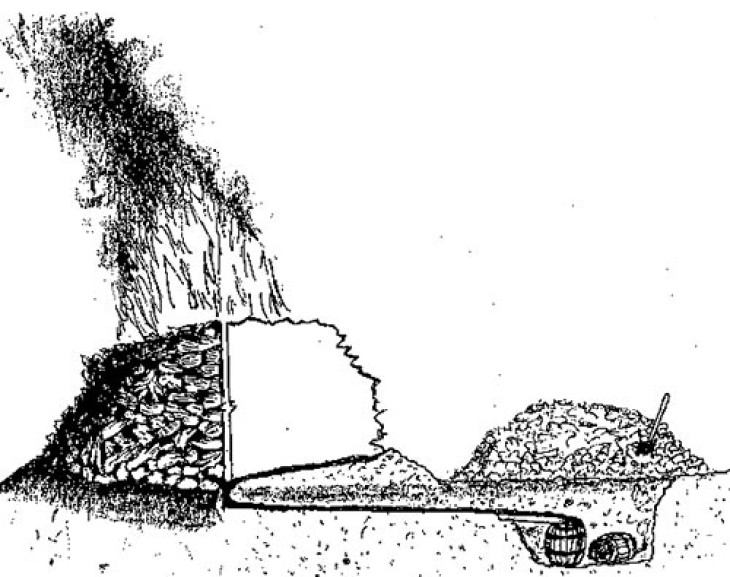
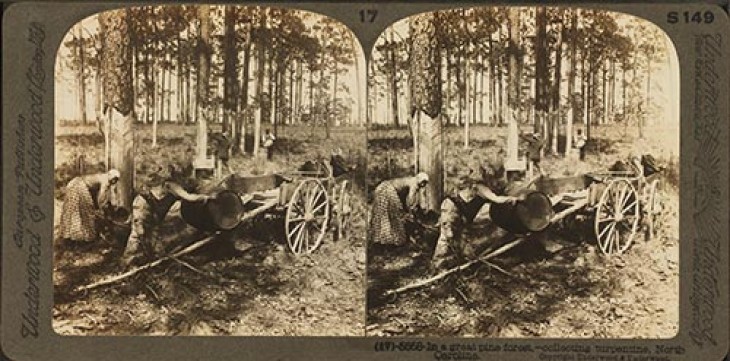
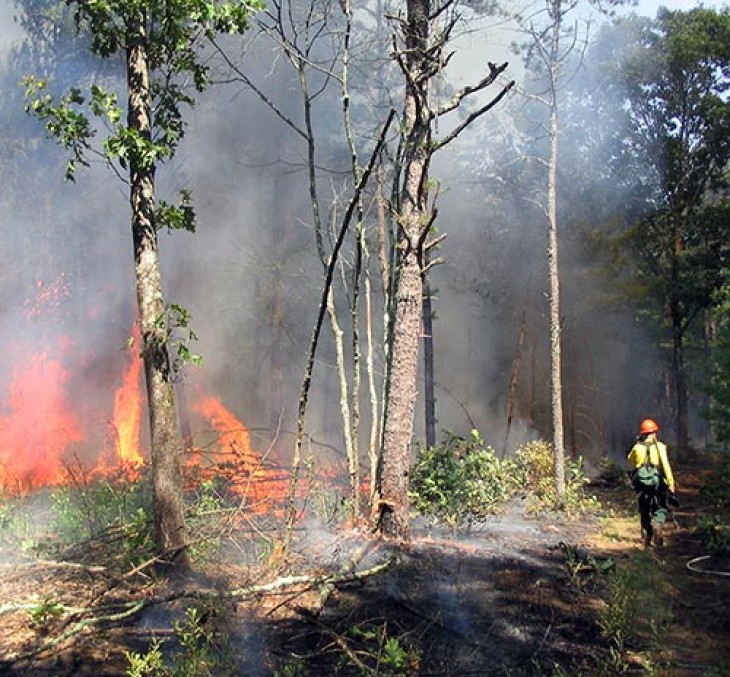
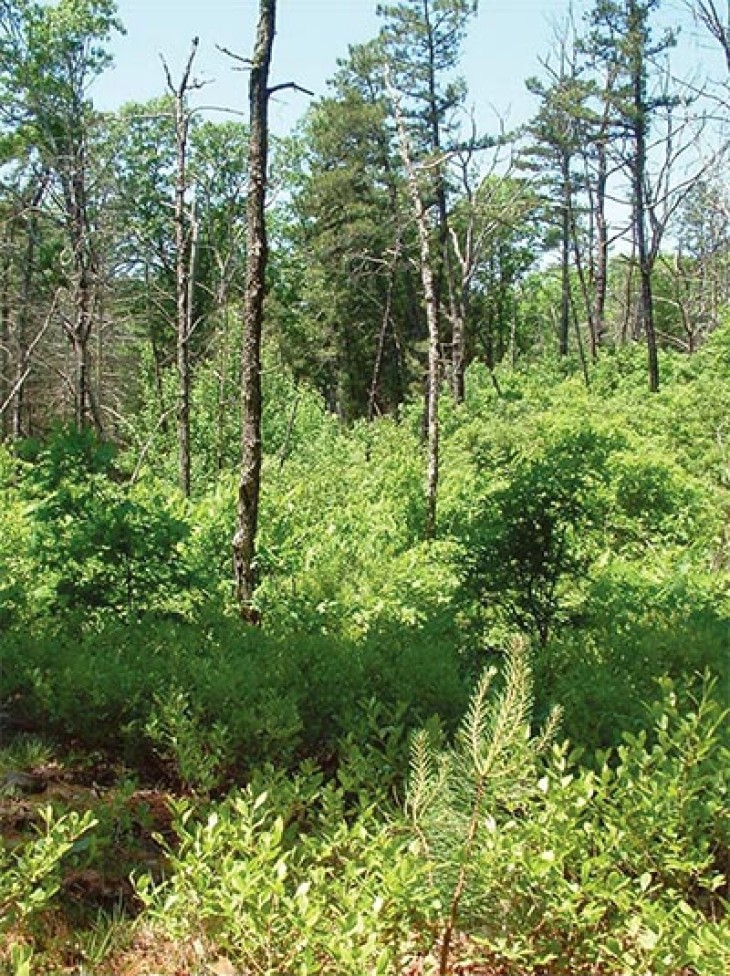
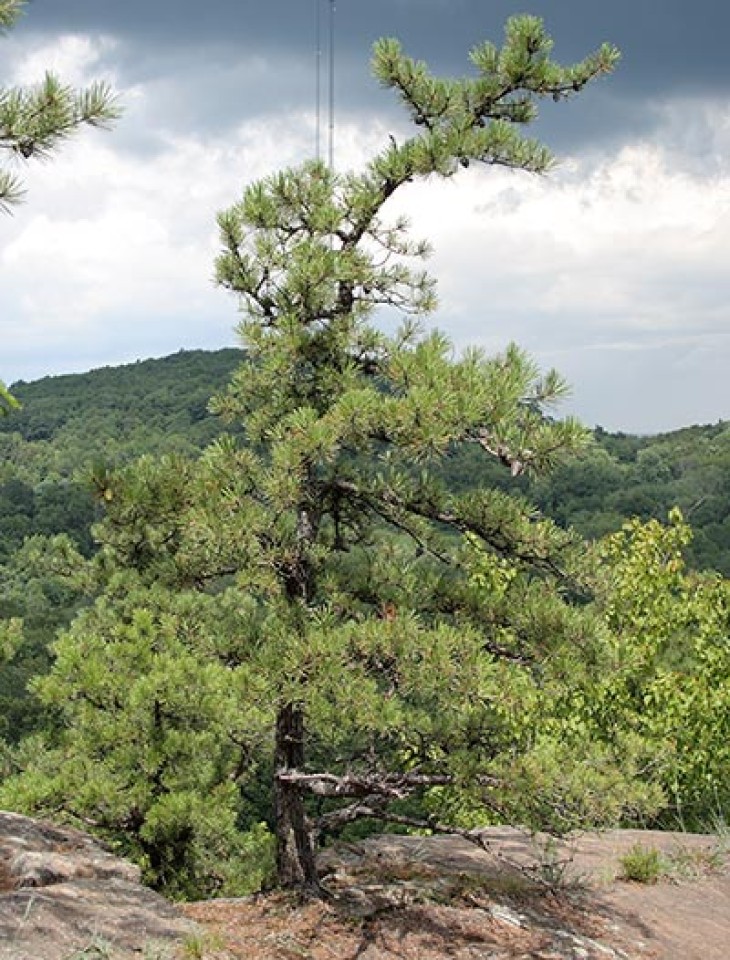
Discussion *